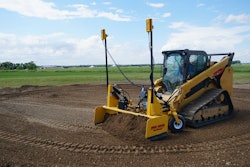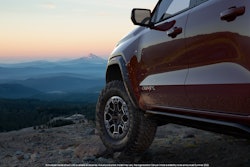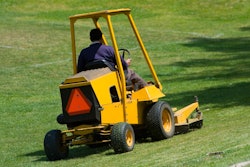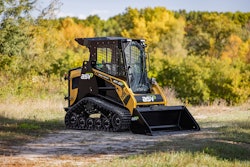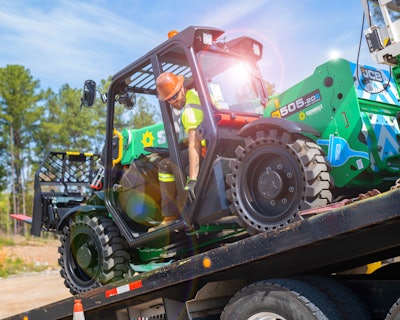
Despite unprecedented supply chain constraints and product delays, 2022 has been a strong year for the equipment rental industry.
As the Covid pandemic continues through its own path, issues such as lack of skilled workers and rising material prices have amplified cautions within the construction industry. Some construction companies are renting to increase their margins.
“Contractors, construction managers and otherwise are increasingly turning to equipment rental for an ever improving and reliable alternative to ownership,” says Brad Coverdale, Sunbelt Rentals vice president of fleet and product support.
For many heavy equipment users, being unable to get the right equipment and labor has led to delayed projects. As a result, they’re looking to rent more powerful, efficient equipment that allows them to do more with less.
“The inability of manufacturers to provide a sufficient number of machines to dealers and rental houses for both retail sales and rental fleets has pressed demand for existing rental fleets upward,” says Glen Olson, Ohio Cat rental general sales manager. “If customers can’t buy machines, they are looking to rental fleets to fill the void. The exact spec of the machine needed may not be available, so they are forced to wait or find an acceptable substitution.”
With interest rates rising, the expectation is that contractors will continue to lean on rental to preserve capital and avoid higher rates.
The American Rental Association’s forecast released in May projects U.S. equipment rental revenue, including both construction and general tool, to grow by 11.1% to reach $56 billion.
Construction equipment rental was leading the way with 13% growth this year to a total $41.7 billion following a 10.2% increase in 2021.
“If there is a silver lining to the inventory-constrained environment, we are hearing from customers who ordinarily haven’t had us in their selection mix in the past,” Olson says. “Customers are trying to find rental machines wherever they can source them to meet their needs.”
Supply and demand
Supply challenges have been both a boon and a bane for the equipment rental market.
“Manufacturers of new machines can’t meet the demand due to the challenges they are facing in their own supply chain and labor issues,” Olson says. “Used machine pricing has skyrocketed, making it somewhat impractical to put an aged machine into a rental fleet when it’s likely a significant FMV (fair market value) markdown will have to be taken later.”
Data from Randall Reilly’s EquipmentWatch market trends reports suggest that Olson is right. Prices for used compact machines such as compact track loaders, skid steer loaders and compact excavators have all been steadily increasing in the past year. Records indicate that telescoping boom rough-terrain lift trucks have also increased significantly over the past 12 months.
Larger machines such as wheel loaders and crawler excavators increased from 2020 to 2021 and appear to be coming down some this year. Standard crawler dozer prices went up during the pandemic, and while reduced from a high of $265,090 in 2021, they have remained in the $250,000 range.
From a supply perspective there doesn’t appear to be much relief in sight, even though the experts were saying that the supply may be flowing more freely in 2023. However, in the second quarter, record-high gas prices and the continued invasion of Ukraine offered little reassurance that those supply chain snags would untangle this year or even in early 2023.
According to EquipmentWatch, the latest survey from the Institute for Supply Management (ISM) showed an improvement of supplier deliveries between May and June. The same survey found that production slowed down to rates not seen since June 2020. These mixed signals make it hard to predict when new equipment manufacturing will truly rebound and only leaves further questions for equipment rental dealers.
“The concern now is we have curtailed our rental fleet rollouts as we don’t have a guaranteed replacement for a sold unit, so we are keeping machines longer and eventually we will see increased maintenance and repair costs,” Olson says. “Parts shortages and delays are common, both on ordinary wear items and more complex components, so when a machine does go down for more than a minor repair or service, it is frustrating to watch the machine stay in a condition in which it can’t be rented while the opportunity to earn revenue from it passes by.”
He notes that downed machines are the major obstacle to maximizing rental revenue in the current environment.
Like the increased prices for used equipment, EquipmentWatch’s Q2 rental market report shows that daily, weekly and monthly rental rates for a variety of machines increased almost across the board.
Versatile equipment like crawler excavators and rough-terrain telehandlers are seeing the highest rates of increase in rental prices. The only exceptions in the top 10 most-rented machines were I.C. pneumatic fork lifts and standard crawler dozers.
The fork lifts appear to be an outlier with 1.6% to 3% declines across the board. Outside of them, standard crawler dozers' average daily rental rate decreased by 1.12% compared to the previous quarter to an average rate of $833. However, both the weekly ($2,451) and monthly ($6,637) rates were up 0.27% and 2.07%, respectively.
At the opposite end of the spectrum, telehandlers, electric self-propelled scissor lifts and crawler excavators saw the largest increases in rates.
In Q2, crawler excavators saw increases of nearly 6% in both weekly and monthly rates, which were averaging at $2,786 and $7,187. In addition, the daily rates climbed 3.79% to $979. The remainder of the top 10 – articulated wheel loaders, single-drum vibratory compactors, compact track loaders, compact excavators, skid steer loaders and scissor lifts – ranged in increases in daily, weekly or monthly rates of .83% to 5.79%. Generally, the average weekly rate trends among those machines indicate a general increase in the past year, with the most volatile being the pneumatic fork lifts. For EquipmentWatch’s analysis, the retail rental rates are an overall average by equipment type and are derived from average rates advertised by distributors throughout the United States and Canada.
“There is a continued demand for equipment rental, which is increasing utilization rates within the industry,” Coverdale says. “Rental equipment inventory is hard to come by, and the companies capable of longer-term planning with their key partner OEMs and ones with the intellectual and financial capital are the ones getting the equipment. Because of this, inventory levels across the industry have not been able to increase at a pace like in prior economic cycles. There is simply not the supply capacity to do so.”
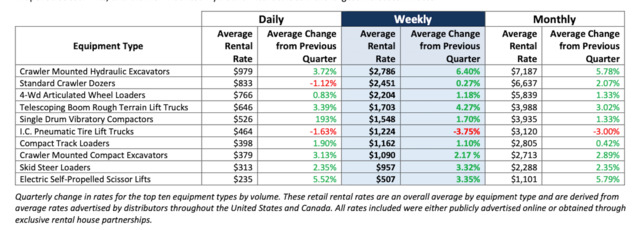 EquipmentWatch
EquipmentWatch
Rise of the machines
With the reliance on rental machines growing, there will come more demand for equipment with expanded features and benefits versus a standard rental configuration. Olson suggests that going forward, technology, especially in telematics, machine control and guidance, will continue to be in demand in the rental space.
“I think we are a bit of time away from seeing the demand for autonomous machines in rental fleets, but it may not be as far away as one would think,” he says.
As an example, Coverdale says, Sunbelt customers will start to find more electric equipment from their rental partners. Over just the past year, the company has invested in implementation of more electric equipment for its overall fleet including the Bobcat T7X all-electric compact track loader and a recent order of 700 Ford F-150 Lightning trucks for their on-the-road fleet. The anticipation is other rental companies and outlets will follow similar paths.
“Rental fleets, especially OEM dealership rental fleets, should be thinking now about how these types of machines may become more prevalent in rental fleets in the future,” Olson says. “I think we will also continue to see demand for more battery-powered offerings. Planning for incorporating and maintaining this type of machine technology in the future is also important.”
Looking ahead
Barring any significant activity that could bring the economy to a halt, both Coverdale and Olson agreed that demand is expected to remain strong for the remainder of 2022 and into 2023.
“Our outlook remains positive as current activity levels are strong and construction continues to forecast new starts in sizable projects,” Coverdale says. “This is further complemented by robust activity in non-construction markets such as facility maintenance, live events and municipality operating needs. These end markets are producing incremental customer demand due to activity levels, coupled with ongoing supply constraints, inflation pressures and labor shortages.”
Olson anticipates project completion dates to be extended as work can't be completed without rental machines being available in a timely manner. So far, he says, they haven’t seen a slowdown in the architectural activity, keeping the pipeline of future work relatively full. Whether increasing interest rates will impact the ABI remains to the seen.
“Construction is also a lagging indicator, so even though the Fed has taken tightening actions now, it may be a bit longer before the impact of that is felt in terms of projects,” Olson says. “The work that is occurring now was planned well before it appeared the Fed would take such aggressive action with interest rates in an attempt to cool the economy.”
Even with an overall positive vibe, there remains unanswered questions. The current trends in supply and labor are forecast to continue. Also, it remains unknown how to interpret the mixed messages coming from manufacturers as to the actual impacts of those challenges. Outside of the Federal Reserve continuing to raise interest rates to address inflation, it remains to be seen how the ramp up of the Infrastructure Investment and Jobs Act (IIJA) will impact demand as well.
“We believe rental will continue to play an increasing role in the broader equipment industry as periods like we are in today produce a step change in product rental penetration,” Coverdale says. “With this change, customers of all types will further themselves from ownership and the many necessities owning equipment brings with it. As this structural change progresses, it doesn’t easily go backward. Contractors need equipment that can get the job done, and they are able to turn to rental to fill their needs and increase efficiencies.”
Rent or buy?
“The rental model offers value and flexibility compared to equipment ownership,” Coverdale says. “For those interested in new technology, rental allows contractors to try new, innovative solutions to determine use case and viability without the risk of the capital investment.”
The Sunbelt Rentals executive added that renting equipment is more practical given it is an operational cost, and the rental partner takes on the care and maintenance, making it cost effective.
“As contractors’ fleets age due to ongoing order backlogs, rental will support their projects with newer, more reliable equipment,” Coverdale says.
Olson says he continues to encourage customers to purchase a core fleet and rent the less-often-needed machines, as well as those it doesn’t make financial sense for the contractor to own.
“We feel this is the most advantageous situation a customer who works in the dirt (excavation, concrete, site utilities, etc.) can find themselves in as the consistency an operator experiences in running the same brand of machine they’re used to running leads to enhanced productivity,” he says. “Our peers in the national rental space will continue to encourage customers to rent as much as possible and rely on their fleet management software capabilities to manage both their rented equipment and what equipment the customer may own.”
On a more basic level, Olson says, equipment rental can also help in unexpected situations, if the contractor has a contingency plan.
“I would encourage fleet managers to think more about what happens if that machine that has been acting up ultimately fails and isn’t able to return to service quickly based on the parts delays and waiting lists at dealerships for both field service and shop work,” he added. “It would be wise to have a contingency plan as to what type of machine can be used, even if it isn’t spec for spec, if that machine ends up failing. While this isn’t always a practical solution, that moment of thinking ahead about where to turn for a replacement machine can be the difference between finding a machine that would work in the short-term and another customer taking that machine for their own rental needs.”
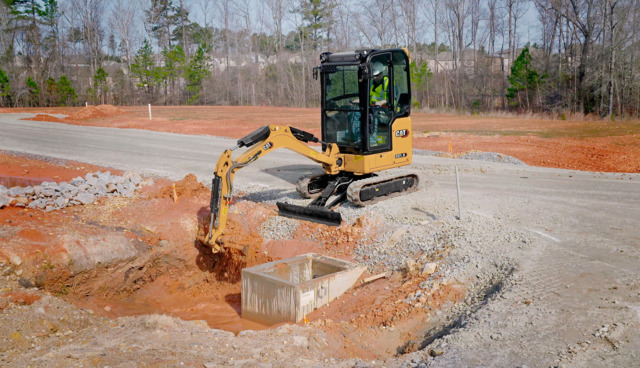 Cat
Cat


